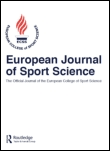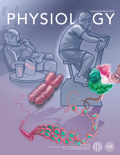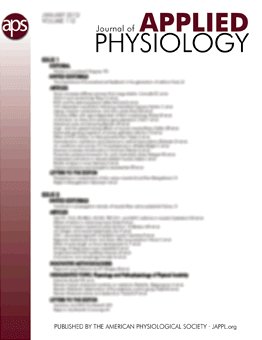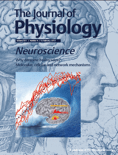
Comparative Exercise Physiology
Scope & Guideline
Advancing the Science of Movement Across Species
Introduction
Aims and Scopes
- Comparative Physiology:
The journal emphasizes comparative studies that analyze physiological responses to exercise across different species, including humans and various animals such as horses and dogs. - Exercise Interventions and Health Outcomes:
Research often explores the effects of different exercise modalities and interventions on health parameters, recovery, and performance, targeting populations ranging from elite athletes to those with chronic conditions. - Injury Prevention and Rehabilitation:
There is a consistent focus on understanding injury mechanisms and developing effective prevention and rehabilitation strategies through exercise, particularly in equestrian sports and canine athletes. - Nutrition and Supplementation in Exercise:
The journal frequently addresses the role of nutritional supplements and dietary interventions in enhancing performance and recovery from exercise. - Innovative Training Techniques:
Studies often investigate novel training techniques and their physiological impacts, contributing to the development of best practices in exercise training for both humans and animals.
Trending and Emerging
- Integration of Technology in Exercise Science:
There is a growing trend towards the use of technology, such as wearable devices and digital monitoring, to assess physiological responses and improve training outcomes in both human and animal subjects. - Focus on Chronic Conditions and Rehabilitation:
Research addressing the impact of exercise on chronic conditions, such as diabetes, obesity, and post-COVID recovery, is increasingly prevalent, reflecting a societal shift towards understanding the role of exercise in health management. - Psychological Aspects of Exercise:
Emerging studies are beginning to explore the psychological impacts of exercise, including mental health benefits and the psychological responses of athletes, indicating a holistic approach to exercise physiology. - Comparative Studies on Performance Enhancements:
There is a noticeable increase in research examining performance enhancements through various interventions, including supplementation and training techniques, across species, particularly in elite sports contexts. - Youth and Aging Populations in Exercise Research:
There is a rising interest in the effects of exercise on youth and aging populations, addressing specific physiological responses and adaptations unique to these demographics.
Declining or Waning
- Traditional Training Methods:
Research focusing solely on traditional training methods without incorporating modern techniques or interdisciplinary approaches is becoming less prevalent, as the field evolves towards more integrative and innovative practices. - Animal-Specific Studies:
Studies that solely focus on physiological responses in one species, without comparative analysis or broader implications for other species, are declining, as the journal increasingly emphasizes cross-species insights. - Basic Physiological Mechanisms:
While foundational research is still important, there is a noticeable shift towards applied research that translates physiological findings into practical applications, leading to a decrease in purely theoretical studies.
Similar Journals

European Journal of Sport Science
Exploring Excellence in Sports MedicineEuropean Journal of Sport Science, published by WILEY, is a preeminent platform in the realm of sports science and medicine, with a keen focus on advanced research and interdisciplinary approaches that propel the field forward. The journal boasts impressive accolades, including a Q1 ranking across multiple categories such as Medicine (miscellaneous), Orthopedics and Sports Medicine, and Physical Therapy, reflecting its significant influence and contribution to the academic community. The 2023 Scopus rankings place it at Rank #26 in Physical Therapy and Rehabilitation and Rank #37 in Orthopedics, underscoring its esteemed position within the top percentile of its peers. With a history spanning from 2001 to 2024, this scholarly journal invites contributions that highlight innovative research, clinical advancements, and comprehensive reviews pertinent to both practitioners and academics dedicated to enhancing performance and rehabilitation in sports. Although not an open-access journal, its subscription model ensures that high-quality, rigorously peer-reviewed content is disseminated, making it a cornerstone resource for researchers and professionals alike seeking to further their expertise in this dynamic field.

PHYSIOLOGY
Leading the Charge in Physiological InnovationPHYSIOLOGY, published by the American Physiological Society, is a leading peer-reviewed journal that has attained an impressive Q1 ranking in the field of Physiology, underscoring its significance in advancing research and knowledge dissemination. With a robust impact factor reflective of its high-quality publications, this journal serves as a critical platform for researchers and professionals to publish their innovative findings. Offering open access options, PHYSIOLOGY ensures wide accessibility to cutting-edge research that spans various aspects of physiological sciences. The journal's dedicated focus on interdisciplinary research enhances its appeal to a diverse audience, facilitating collaborations and discussions that push the boundaries of our understanding in physiology. Established in 2004 and converging toward 2024, PHYSIOLOGY stands at the forefront of scientific inquiry, making a substantial impact in the fields of biochemistry, genetics, and molecular biology.

Journal of Applied Physiology
Advancing the Frontiers of Physiology and Health.The Journal of Applied Physiology, established in 1948 and published by the American Physiological Society, stands as a cornerstone in the field of physiology and applied health sciences. With an impact factor reflecting its rigorous scholarly contributions, this peer-reviewed journal ranks in the Q1 category for both Medicine (miscellaneous) and Physiology as of 2023, further emphasizing its prestige and relevance. Researchers and practitioners are drawn to its comprehensive scope, which includes physiological and biomechanical responses relevant to health, exercise, and clinical practices, making it an essential resource for advancements in sports science and medical physiology. Though it does not offer Open Access, the journal provides a wealth of high-quality research, with contributions that are crucial for understanding the complexities of human physiology. Its inclusion in Scopus ranks demonstrates a solid commitment to advancing knowledge in the field, appealing to a diverse audience of researchers, professionals, and students committed to exploring the intricate interactions between physiological processes and applied health.

Sport Sciences for Health
Advancing Health Through Sport Science InsightsSport Sciences for Health is a leading journal published by SPRINGERNATURE that aims to advance the understanding and application of sports science within healthcare contexts. Established in 2004, this journal has successfully provided a platform for innovative research and discussions in the fields of Orthopedics, Sports Medicine, and general Sports Science, achieving a commendable Q3 ranking in both categories as per the 2023 Scopus quartile rankings. With an active publication schedule through 2024, Sport Sciences for Health offers invaluable insights for researchers, professionals, and students who are eager to explore the intricate relationships between sport and health outcomes. This journal, set in Italy, encourages the dissemination of significant findings that can enhance athletic performance, rehabilitation strategies, and public health initiatives, fostering an integrative approach to both theory and practical applications in the realm of sport sciences.

Translational Sports Medicine
Innovating Sports Medicine through Open AccessTranslational Sports Medicine, published by WILEY-HINDAWI, is a distinguished open access journal that has been at the forefront of sports medicine research since its inception in 2018. With an E-ISSN of 2573-8488, this journal aims to bridge the gap between laboratory research and clinical application, fostering the translation of groundbreaking findings into effective sports medicine practices. Situated in the United Kingdom, it has achieved recognition in the academic community, currently holding a Q2 ranking in the fields of Orthopedics and Sports Medicine, with a Scopus ranking of #143 out of 321 in its category. The journal welcomes diverse contributions, making it an essential resource for researchers, professionals, and students eager to advance their understanding of the field. With open access options since 2022, Translational Sports Medicine ensures that high-quality research is accessible to a global audience, thereby enhancing the dissemination of knowledge that can significantly impact sports health and performance.

MEDICINA DELLO SPORT
Elevating the Standards of Sports Health KnowledgeMEDICINA DELLO SPORT is a distinguished journal published by EDIZIONI MINERVA MEDICA, dedicated to advancing knowledge in orthopedics, sports medicine, and physical therapy. With its ISSN 0025-7826 and E-ISSN 1827-1863, this journal has been a pivotal platform for scholarly research since its inception in 1965, enhancing the understanding of various aspects of sports health and rehabilitation. Although it currently does not offer open access, it maintains a reputable stance in academic publishing, ranking in Q3 for both Orthopedics and Sports Medicine as well as Physical Therapy, Sports Therapy, and Rehabilitation, according to the latest metrics. With its inclusion in Scopus and a strong presence in important health professions, MEDICINA DELLO SPORT is crucial for researchers, professionals, and students aiming to explore and contribute to the evolving field of sports medicine and therapies. It is published from its headquarters located at CORSO BRAMANTE 83-85 INT JOURNALS DEPT., 10126 TURIN, ITALY, ensuring a European perspective in global health discussions.

JOURNAL OF PHYSIOLOGY-LONDON
Driving Innovation in Physiological ResearchJOURNAL OF PHYSIOLOGY-LONDON, published by WILEY, stands as a prestigious beacon in the fields of Physiology and Sports Science. Established in 1878, this journal has a rich history of disseminating crucial research findings and advancing scientific knowledge, continuing its impact into the present day with an anticipated convergence in 2024. Recognized for its excellence, it ranks in the Q1 category for both Physiology and Sports Science in 2023, cementing its position within the top echelons of academic publications. With a Scopus rank of #26 out of 193 in the Biochemistry, Genetics and Molecular Biology _ Physiology category, the journal boasts an impressive 86th percentile, reflecting its high-quality contributions to the scientific community. Although not open access, its extensive archive and reputation ensure that it remains a vital resource for researchers, professionals, and students eager to stay at the forefront of physiological science. For those looking to deepen their understanding of physiological mechanisms and their applications, the JOURNAL OF PHYSIOLOGY-LONDON is an indispensable resource.

Journal of Science in Sport and Exercise
Unlocking New Insights in Sports Science and RehabilitationJournal of Science in Sport and Exercise, published by SPRINGERNATURE, is a premier academic platform dedicated to advancing knowledge across the fields of sports science, exercise physiology, and rehabilitation. Since its inception, the journal has grown to occupy significant quartiles in renowned categories such as Nutrition and Dietetics, Orthopedics and Sports Medicine, and Physical Therapy, underscored by its Scopus rankings that demonstrate a solid standing among global peers. The journal's focus encompasses a wide array of research topics, promoting interdisciplinary collaboration and the application of innovative methodologies. With a commitment to open access, Journal of Science in Sport and Exercise aims to provide researchers, professionals, and students with accessible, high-quality studies that foster evidence-based practices in both clinical and athletic settings. Published every year until 2024, the journal is poised to remain a vital resource for advancing the science of sport and exercise, inviting contributions that push the boundaries of knowledge and enhance athletic performance.

Journal of Exercise Rehabilitation
Empowering Recovery with Cutting-Edge Exercise InsightsThe Journal of Exercise Rehabilitation is a leading academic publication dedicated to advancing the field of physical therapy, sports therapy, and rehabilitation. Published by the Korean Society of Exercise Rehabilitation, this open-access journal, available since 2013, facilitates the dissemination of high-quality research and innovative practices in exercise rehabilitation. With an impressive impact factor and an H-index reflecting its academic influence, the journal is ranked in the Q2 category for Physical Therapy and Sports Therapy and Rehabilitation, and Q3 for Orthopedics and Sports Medicine as of 2023. Operating from South Korea, it serves as a vital platform for researchers, practitioners, and students alike, fostering collaboration and the sharing of knowledge across borders. By including studies that span from 2017 to 2024, it not only highlights significant advances in the field but also encourages ongoing exploration and discussion. Engage with the Journal of Exercise Rehabilitation to contribute to this dynamic and evolving discourse in rehabilitation science.

Applied Physiology Nutrition and Metabolism
Transforming Knowledge into Healthier LivesApplied Physiology, Nutrition, and Metabolism is a renowned journal published by Canadian Science Publishing, focusing on the interdisciplinary fields of physiology, nutrition, and metabolic science. Since its inception in 2006, this journal has established itself as a leading source of cutting-edge research, providing a platform for innovative studies that impact clinical practices, fitness, and health guidelines. With an impressive recognition within the academic community, it boasts a Q1 rank in Nutrition and Dietetics and Q2 ranks in Endocrinology, Diabetes and Metabolism, and Physiology categories in 2023, highlighting its significance in advancing knowledge in these critical areas. The journal offers open access options, promoting broader dissemination of research findings to enhance global health outcomes. Situated in Canada, Applied Physiology, Nutrition, and Metabolism aims to integrate science and practical applications, making it essential reading for researchers, clinicians, and students dedicated to exploring the dynamic interactions between nutrition, physical activity, and metabolic health.